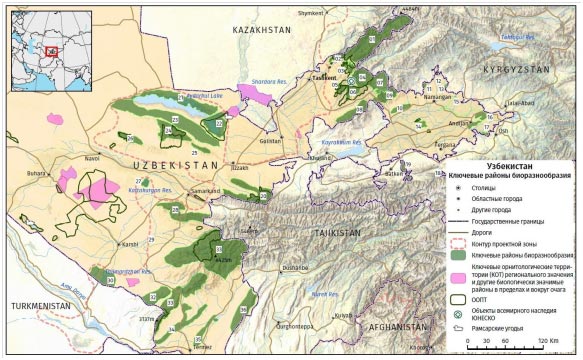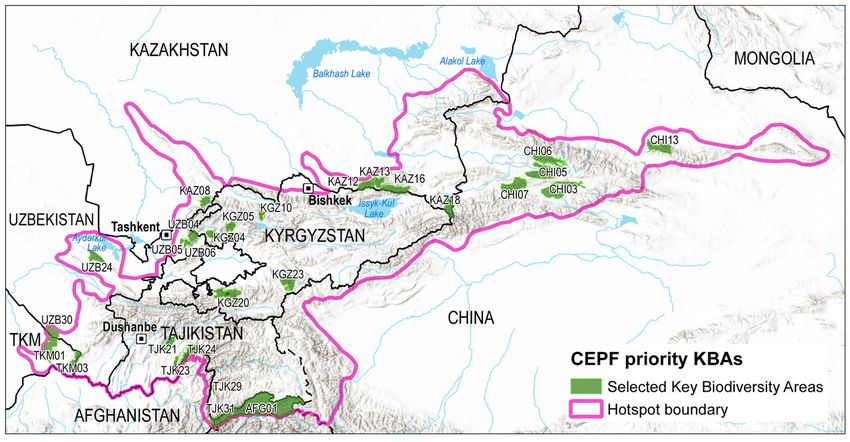Eligible Countries: Kazakhstan, Kyrgyzstan, Tajikistan, Turkmenistan, Uzbekistan
Opening Date: Tuesday, 15 December 2020
Closing Date: Saturday, 16 January 2021 [13:00: Ashgabat, Dushanbe, Tashkent] [14:00: Almaty, Bishkek]
Grant Size: US$20,000 to US$150,000
CEPF and WWF Central Asia, as regional implementation team for the hotspot, are accepting letters of inquiry (LOIs) from non-government organizations, community groups, indigenous people’s organizations, women’s groups, private companies and other civil society organizations (CSOs) in relation to the eligible activities and geographies described below. This is the second of several large-grant calls for proposals (CFP) that will be made public through 2024.
BACKGROUND
The Critical Ecosystem Partnership Fund (CEPF) is a joint initiative of l’Agence Française de Développement, Conservation International, the European Union,the Global Environment Facility, the Government of Japan and the World Bank. A fundamental goal is to ensure civil society is engaged in biodiversity conservation.
The Mountains of Central Asia Biodiversity Hotspot covers varying proportions of Afghanistan, China, Kazakhstan, the Kyrgyz Republic, Tajikistan, Turkmenistan and Uzbekistan. CEPF’s niche for investment in the region was formulated through a participatory process that engaged civil society, donor and government stakeholders throughout the region. The resulting investment strategy (2019-2024) is documented within the ecosystem profile, available in English (PDF – 5.5 MB) and Russian (PDF – 7 MB). This investment strategy is comprised of a series of strategic directions, broken down into investment priorities outlining the types of activities that are eligible for CEPF funding.
Applicants are strongly encouraged to familiarize themselves with the CEPF website, particularly the sections on Eligibility, Before You Apply and How to Apply. Potential applicants who are uncertain of the eligibility of their organization or project concept are encouraged to contact the people listed below for clarification.
ELIGIBLE ACTIVITIES
The scope of this call is limited to the types of activities and locations described below. LOIs will only be accepted for the following strategic directions and countries:
- Strategic Directions: 1, 2, 4, 5
- Countries: Kazakhstan, Kyrgyzstan, Tajikistan, Turkmenistan, Uzbekistan
Themes:
- Strengthening the Protected Areas of Turkmenistan
The following are items of focus for this round of letters of inquiry in Turkmenistan.
- Strengthening existing protection measures for ecosystems and species, including endemic plants, birds of prey and ungulates.
- Strengthening engagement of communities around protected areas and supporting adoption of sustainable livelihoods.
- Identification of gaps in the protected area network and gaps in management of existing areas.
- Monitoring of species.
- Raising awareness of the importance of species, protected areas and Key Biodiversity Areas (KBAs) among the local population.
- Reducing pressures from over-grazing and illegal hunting.
- Wetland management focused on the conservation of threatened species.
- Transboundary activities with Uzbekistan, including raising awareness about the value of this, improving the network of transboundary protected areas to facilitate connectivity, and meeting the requirements for nomination of a UNESCO World Heritage site.
CEPF groups its work by investment priorities. Applicants wishing to address any of the above bullets should frame their work per any of the following investment priorities:
1.5. Maintain populations of priority species beyond those solely affected by collection, hunting, fishing, grazing and farming.
2.1. Facilitate effective collaboration among CSOs, local communities, and park management units to enhance protected area networks.
2.3. Build support and develop capacity for identification and recognition of KBAs.
4.1. Engage hunting associations, tourism operators and mining companies in conservation management and establishing valuation mechanisms for biodiversity and ecosystem services.
When addressing any of the above, work should focus on:
- KBA 1: Koytendag (a CEPF priority KBA)
- KBA 2: Tallymerjen (a CEPF priority KBA)
CEPF will consider work outside of priority KBAs, but within the two corridors named below, if the work is closely aligned the relevant investment priorities.
- Corridor 1 Kelif-Talimarjan-Termez wetlands
- Corridor 4: Koytendag and Hissar mountains
- Transboundary work in Uzbekistan
The following are items of focus for this round of letters of inquiry in Uzbekistan.
- Protection of threatened species and globally significant aggregations.
- Engagement of local land managers and capacity building for more effective functioning of KBAs.
- Monitoring of species.
- Raising awareness of the importance of species, protected areas and KBAs among the local population.
- Promotion of the value of transboundary activities with Turkmenistan, improving the network of transboundary protected areas to facilitate connectivity, and meeting the requirements for nomination of a UNESCO World Heritage site.
Applicants wishing to address any of the above bullets should frame their work per any of the following investment priorities:
2.1. Facilitate effective collaboration among CSOs, local communities and park management units to enhance protected area networks.
3.1. Develop projects and protocols for ecological restoration to improve connectivity of KBAs.
3.2. Evaluate and integrate biodiversity and ecosystem service values into land-use and development planning.
3.3. Support civil society efforts to analyze development plans and programs; evaluate their impact on biodiversity, communities and livelihoods; and propose alternative scenarios and appropriate mitigation measures.
5.1. Enable and enhance communication and collaboration between civil society, communities and government agencies responsible for implementing national biodiversity strategies.
When addressing any of the above, work should focus on:
- KBA 30: Talimarjan Reservoir (a CEPF priority KBA)
CEPF will consider work outside of priority KBAs, but within non-priority KBAs and corridors named below, if the work is closely aligned the relevant investment priorities and promotes transboundary cooperation with Turkmenistan.
- KBA 32: Tarkapchigay River Basin
- KBA 33: Kugitang and Baysuntay
- KBA 34: Kelif-Sherabad Range
- Corridor 1 Kelif-Talimarjan-Termez wetlands
- Corridor 4: Koytendag and Hissar Mountains
- Livelihoods, Ecotourism and Improved Land Use in the Khan-Tengri and Tomur Mountains Corridor and Other Priority KBAs
CEPF particularly seeks work in the Khan-Tengri and Tomur mountains, CEPF priority Corridor 18, as well as in other priority KBAs and corridors, focusing on:
- Strengthening the management of protected areas.
- Improving livelihoods and delivering ecosystem services without damaging biodiversity.
- Strengthening CSO participation and decision-making for conservation inside and outside of protected areas.
Applicants wishing to address any of the above bullets should frame their work per any of the following investment priorities:
2.1. Facilitate effective collaboration among CSOs, local communities and park management units to enhance protected area networks.
2.2. Develop and implement management approaches to sustainable use in KBAs outside official protected areas.
4.1. Engage hunting associations, tourism operators and mining companies in conservation management and in establishing valuation mechanisms for biodiversity and ecosystem services.
4.2. Promote mainstreaming of conservation into livestock and farm management practices.
4.3. Promote sustainable forest certification and value chains for non-timber forest products.
4.4. Engage with the government and private sector to incorporate site safeguards into infrastructure development.
4.5. Engage the media as a tool to increase awareness about globally threatened species and KBAs and inform public debate of conservation issues.
5.2. Enhance CSOs’ capacity for planning, implementation, outreach, sharing of best practice, fundraising and communication.
5.3. Catalyze networking and collaboration among CSOs and between them and public sector partners.
.
- Species-Specific Projects Targeting One or More of the Following Species
- Bukhara deer (Cervus hanglu), especially projects that have synergies with the recently revised CMS/CAMI Work Programme for the Bukhara deer (2021-2026)
- Pike asp (Aspiolucius esocinus)
- Amudarya shovelnose sturgeon (Pseudoscaphirhynchus kaufmanni)
Projects focusing on other priority species are also eligible, but we particularly welcome projects conserving the four species named above.
Applicants wishing to address any of the above bullets should frame their work per any of the following investment priorities:
1.1. Improve enforcement and develop incentives and alternatives for nature users and collectors.
1.2. Promote improved regulation of collecting, hunting and fishing.
1.3. Support the development of species-specific reserves and conservation programs.
1.5. Maintain populations of priority species beyond those solely affected by collection, hunting, fishing, grazing and farming.
- SMART
Implementing a spatial monitoring and report tool (SMART) approach in the region, including:
- Training of protected area managers in the use of the methodology.
- Using implementation of the methodology to form the basis for greater cooperation and collaboration between protected area managers and civil society.
- Using SMART to foster greater transparency in protected area management and promote collaboration with surrounding communities.
This can be placed in the context of any investment priority.
ELIGIBLE GEOGRAPHIC AREAS
CEPF focuses its work on conservation outcomes, seeking to protect species, sites and corridors. The core of this work is around KBAs, which are the refuges of globally threatened species and around which larger corridors are based. Chapter 4 of the ecosystem profile lists all species, KBAs and corridors in the region. Chapter 12 lists the priority species, KBAs and corridors. Unless otherwise noted, applicants should focus on the KBAs and corridors identified in this announcement (above) and in Chapter 12 of the ecosystem profile.
This call for proposals is open only for projects working in Kazakhstan, the Kyrgyz Republic, Tajikistan, Turkmenistan and Uzbekistan. Table 12.2 of the ecosystem profile lists priority KBAs. Table 4.5 (Kazakhstan), Table 4.6 (Kyrgyzstan), Table 4.7 (Tajikistan), Table 4.8 (Turkmenistan) and Table 4.9 (Uzbekistan) of the ecosystem profile list all KBAs in each country, both priority and non-priority.
- Applicants that submit proposals for priority KBAs, from the eligible countries, and that also address the investment priorities named above, will receive the highest consideration from reviewers.
- Applicants that submit proposals for work in non-priority KBAs from the eligible countries must specifically address one of the investment priorities named above to receive any consideration from reviewers. (For example, we will consider work in non-priority locations if the work then addresses a priority species.)
The ecosystem profile lists all KBAs and corridors with specific names and identification/code numbers. Applicants are advised to name specific KBAs and corridors by name and number in your letter of inquiry.
We are willing to consider proposals addressing urgent conservation needs that take place in non-priority KBAs or non-priority corridors. However, such projects must still address the investment priorities named above.
BUDGET AND TIMEFRAME
LOIs must have a budget between US$20,000 and US$150,000 to be eligible for consideration.
Projects are expected to start approximately six to nine months from the release of this call for LOIs. CEPF projects are typically 18-24 months in duration, but all work must be complete by June 2024.
GENERAL GUIDANCE
Project proposals should be built on biodiversity conservation as a fundamental component and should demonstrate positive impacts on the conservation status of biodiversity.
Where relevant, applicants are encouraged to submit LOIs that harmonize with existing national or regional initiatives. Synergies with other organizations are also eligible, with one lead organization submitting the application alongside sub-grantee project partners.
Applicants based outside of eligible countries may submit an LOI as long as the project deliverables are focused on the conservation need within an eligible country/countries.
International organizations are encouraged to involve local organizations or communities as project partners, or explain how local stakeholders will be engaged as part of project implementation.
Applicants are advised to read the investment strategy chapter of the ecosystem profile (Chapter 12) to ensure full understanding of the strategic directions and investment priorities.
HOW TO APPLY
Applicants must respond to the call via the ConservationGrants electronic portal. CEPF will not accept letters of inquiry via email or any other mechanism.
If you have not previously used ConservationGrants, you will need to register for a new account. If you encounter any technical difficulties with ConservationGrants, please email conservationgrants@conservation.org.
SELECTION AND AWARD PROCESS
ConservationGrants will automatically confirm receipt of all LOIs that are properly submitted within the system by the closing date.
The LOI review process will take approximately eight weeks from the closing date. All applicants will receive a response from CEPF following review of their submissions. The review committee will select the strongest LOIs that meet the eligibility criteria.
Applicants whose LOIs receive a positive review will be invited to submit a full proposal, again through ConservationGrants. Full proposals that receive a positive review will lead to the award of a grant between Conservation International, as the host of the CEPF Secretariat, and the applicant’s organization (the “grantee”). Grants will be denominated in United States dollars and grant agreements will be in English.
REFERENCE MATERIALS
All applicants are advised to review the CEPF Investment Strategy for the Mountains of Central Asia within the ecosystem profile (Chapter 12). This provides more detail on the types of activities CEPF will fund under each investment priority:
- Full Ecosystem Profile – English (PDF –5 MB)
- Full Ecosystem Profile – Russian (PDF – 7 MB)
- Ecosystem Profile Technical Summary – English (PDF – 2 MB)
- Ecosystem Profile Technical Summary – Russian (PDF –5 MB)
- Ecosystem Profile Visual Summary – English (PDF – 22 MB)
- Ecosystem Profile Visual Summary – Russian (PDF – 21 MB)
CEPF is committed to integrating gender into its portfolio. Applicants should design projects and write proposals that consider gender issues in the achievement of their conservation impacts.
CEPF has developed several resources that can help applicants to design, implement and evaluate gender-aware projects (CEPF Gender Toolkit, PDF – 359 KB) and understand what CEPF seeks in a proposal (CEPF Gender Fact Sheet, PDF – 352 KB). Visit the CEPF and Gender webpage to learn more about how CEPF addresses gender in the projects it supports.
The integration of gender in your project will be a factor in evaluation.
Additional resources:
- Before You Apply
- 12 Tips for Getting Your Grant Idea Funded
- CEPF Project Database
- Life Cycle of a Grant
- ConservationGrants Frequently Asked Questions
CONTACT
Before applying, applicants are encouraged to discuss project ideas and eligibility with the RIT program officer in your country. Please initiate this discussion by contacting the team leader:
- Lizza Protas, RIT leader: LProtas@fondprirody.ru
Please also see the regional implementation team website, www.mca.earth.
Technical questions regarding the ConservationGrants online system should be emailed to conservationgrants@conservation.org.
NOTE ON CLOSING DATE AND TIME
ConservationGrants is an online database that uses a strict electronic system for closing the period in which it will accept submissions. The ConservationGrants portal will become electronically closed to all submissions at the following time:
California, USA: 16 January 2021 00:00
Washington, D.C., USA :16 January 2021 03:00
GMT: 16 January 2021 08:00
Ashgabat, Dushanbe, Tashkent: 16 January 2021 13:00 (1 p.m. local time)
Almaty, Bishkek: 16 January 2021 14:00 (2 p.m. local time)
MAPS OF KBAS AND CORRIDORS RELEVANT TO THIS ANNOUNCEMENT
Corridor 18. Khan-Tengri and Tomur Mountains
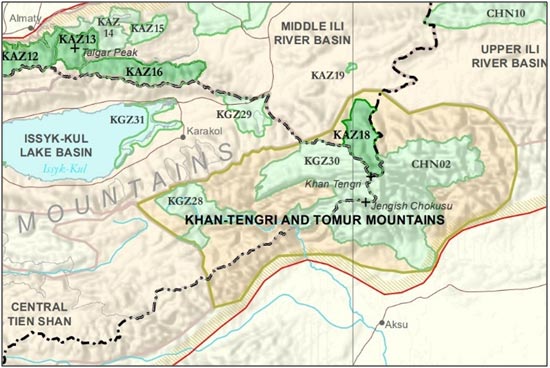
Corridor 1. Kelif-Talimarjan-Termez Wetlands
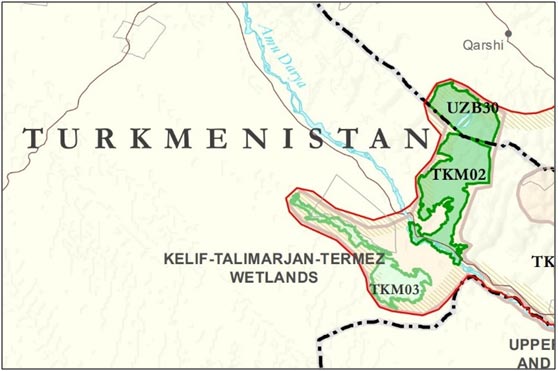
Corridor 4. Koytendag and Hissar Mountains
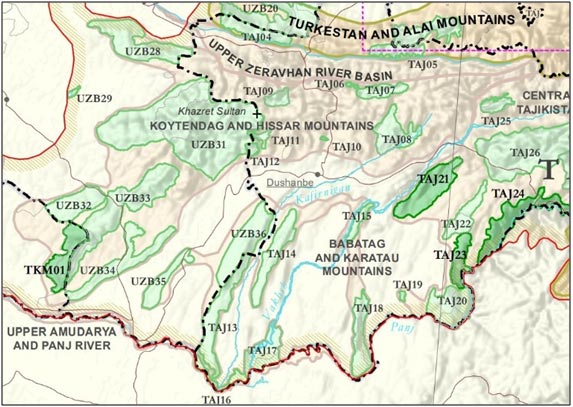
KBAs in Kazakhstan
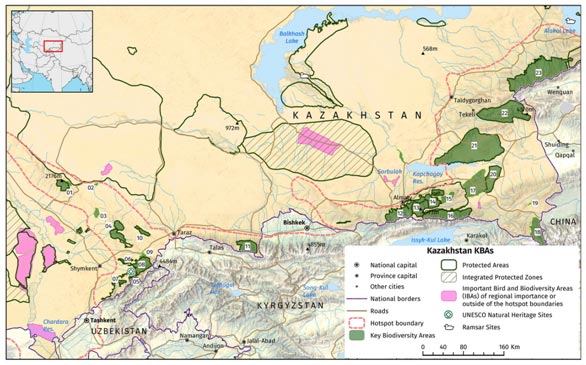
KBAs in Kyrgyzstan
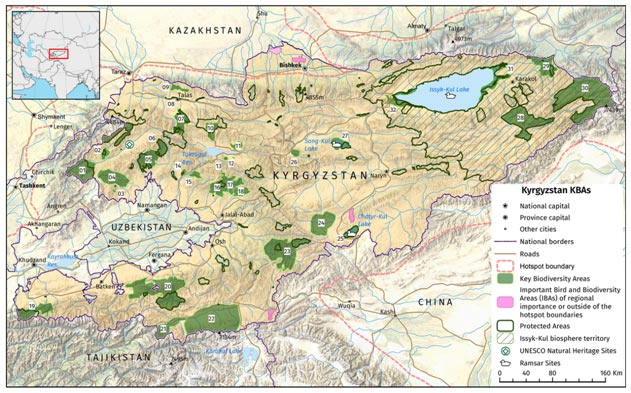
KBAs in Tajikistan
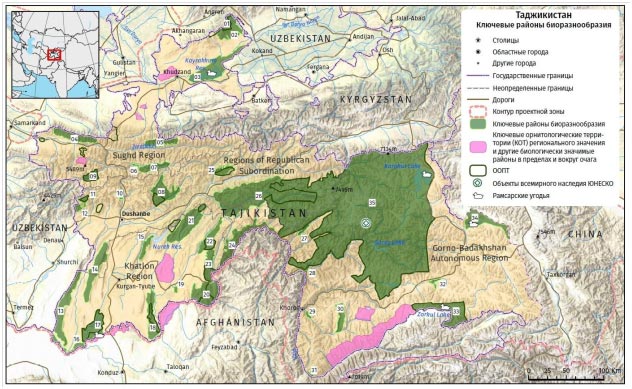
KBAs in Turkmenistan
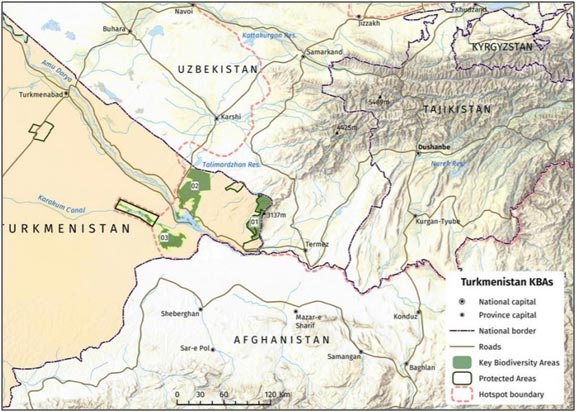
KBAs in Uzbekistan
